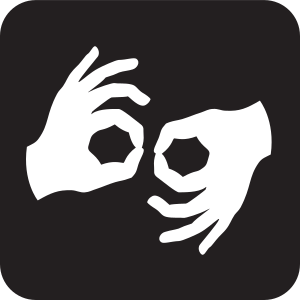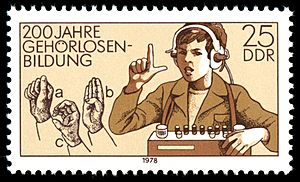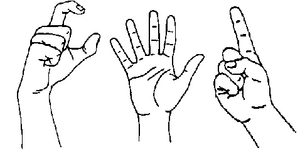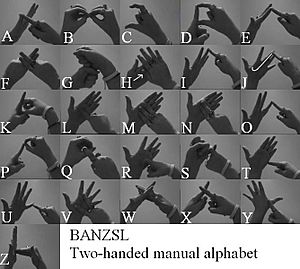Sign language facts for kids

A sign language is a special way to talk using your hands and body. It's super important for deaf people to communicate. Instead of using sounds like spoken languages, sign languages use movements you can see. Deaf people often use sign languages because it's easier for them than spoken languages.
Contents
How People Learn and Use Sign Language
Deaf people sometimes learn sign language from their families, especially if their parents are also deaf. However, most deaf children have parents who can hear. So, they often learn sign language from other deaf people they meet at school or in their community.
People who can hear might learn sign language directly from deaf people. They can also take classes or use special books and DVDs to learn.
Sometimes, deaf people use spoken language, especially when they talk with people who can hear. And sometimes, hearing people use sign language with each other instead of speaking. But generally, deaf people use sign languages, and hearing people use spoken languages.
Some deaf people can also understand spoken words by watching a speaker's lips. This is called lip-reading. It's quite hard to do well. Sometimes, people combine signing and lip-reading, especially when deaf and hearing people are talking together.
The History of Sign Languages
Sign languages have always been around in deaf communities. Ancient writings even mention deaf people and their use of signs. In the Western world, people started studying sign languages more closely in the 1600s.
In 1620, a Spanish priest named Juan Pablo Bonet wrote about teaching deaf people to speak using gestures. Later, in the 1700s, a French priest named Abbé Charles-Michel de l'Épée used Bonet's ideas to create a fingerspelling alphabet. This alphabet, which uses hand shapes for each letter, is still used today in many countries with sign languages.
It's important to know that this alphabet didn't create French Sign Language. Deaf people in France already used an older version of French Sign Language before l'Épée started teaching. They could even read and write in French! This showed everyone that deaf people could learn and think without needing to speak.
Many Different Sign Languages Around the World

Sign languages are not the same everywhere. There isn't just one sign language for all deaf people. Instead, each deaf community can create its own sign language. Usually, each country has its own unique sign language. Experts have found at least 137 different sign languages!
Here are some well-known sign languages:
- American Sign Language (ASL)
- Auslan (Australian Sign Language)
- Austrian Sign Language
- British Sign Language (BSL)
- Indo-Pakistani Sign Language
- Japanese Sign Language (日本手話, Nihon Shuwa) (JSL or NS)
- Mexican Sign Language (Spanish: Lengua de señas mexicana or LSM)
- Nicaraguan sign language
- New Zealand Sign Language (NZSL)
- Quebec Sign Language (French: Langue des signes québécoise, or LSQ)
- Turkish Sign Language (TSL)
Even though there are many sign languages, they can be related. For example, ASL, LSM, and LSQ all came from Old French Sign Language. They are part of the same language family. Some sign languages are very similar, like BSL, Auslan, and NZSL. Linguists sometimes call them "BANZSL" (for British Australian New Zealand Sign Language). Sign languages can also borrow signs from each other, just like spoken languages borrow words.
Understanding Sign Language Grammar
Sign languages are real languages with their own rules, just like spoken languages. They have rules for how signs are put together to make sentences. This includes rules for syntax (sentence structure), morphology (how signs are formed), phonology (the smaller parts of signs), and semantics (meaning). Sign languages are not just random gestures or mime.
The main difference is that sign languages use hand and body movements to create signs, while spoken languages use sounds to create words. Each sign in a sign language is like a word in a spoken language. Both types of languages use grammar rules to combine these words or signs into full sentences. This is what makes them true languages, different from simple gestures.
Just like spoken words are made of smaller sounds (like "p" or "o"), signs are made of smaller parts. These parts include:
- Handshapes
- Movements of the hands
- Locations where the hands are placed
- Facial expressions
- Other body movements
These pieces are combined in different ways to make the signs. Some signs use one hand, others use both. Some signs need specific mouth movements or other body actions to be correct. Other body movements are also important for grammar. For example, in many sign languages, raising your eyebrows can show that you are asking a "yes" or "no" question.
While sign languages have similar ways of forming signs, their grammar rules are not exactly the same. Each sign language has its own unique grammar. For instance, they use different sets of handshapes to create signs.
Sometimes a sign might look like the object or action it represents, but this isn't always true. For many signs, you simply have to learn their meaning, just like you learn words in a spoken language. It's not always easy to guess the meaning just by looking at the sign. This is another way sign languages are different from mime, where the meaning of a gesture is usually very clear. However, once you know a sign's meaning, its form can often help you remember it.
What is Fingerspelling?
Besides regular signs, many sign languages use fingerspelling. This is also called a "hand alphabet." In fingerspelling, each letter of a spoken language's alphabet has its own hand sign.
Fingerspelling is a tool people use to spell out names, acronyms, or other words from spoken languages. They might do this when there isn't a specific sign for a word yet. Sometimes, people fingerspell a word even if there is a normal sign for it. For example, when talking about a person, a signer might spell their name using fingerspelling, or they might use a special "name-sign" for that person.
Fingerspelling systems are different in different sign languages. Some systems use only one hand, like American Sign Language (ASL). Other sign languages use both hands for fingerspelling, like the BANZSL languages. Fingerspelling also changes depending on the writing system of the spoken language. For example, Japanese is written with different letters than English, so fingerspelling in Japanese Sign Language is different from ASL. ASL uses a lot of fingerspelling, but most other sign languages use it less, and some don't use it at all.
Writing Sign Languages
There isn't one official way to write down signs. Some deaf and hearing people think there should be, and they have invented different ways to do it.
Here are a few systems:
- Stokoe notation was created by William Stokoe in 1965 for his dictionary of American Sign Language. It's not used much anymore.
- The Hamburg Notation System (HamNoSys) is a technical system mostly used by experts in Europe for studying sign languages.
- Sign Language International Phonetic Alphabet (SLIPA) is another technical system for research.
- SignWriting was developed by Valerie Sutton starting in 1974. People can use it for everyday writing, and it works for many different sign languages.
- si5s is also for everyday use and is a system for ASL.
- ASL-phabet was designed by Sam Supalla for ASL and has been used in schools for deaf children.
However, many sign language users don't think writing signs is very useful. Usually, deaf people just write in the spoken language of their country instead of trying to write their sign language.
Sign Languages and Deaf Culture
Deaf people have their own special culture. It's similar to the culture of hearing people around them, but there are important differences. Deaf people have unique experiences that shape their culture.
Sign language is the most important part of deaf culture. Through sign language, deaf people can create a shared identity and connect with each other naturally. The shared sign language helps keep their deaf community strong, much like spoken languages do for hearing communities.
Some children are born deaf, while others lose their hearing when they are very young due to illness. These children often learn to sign and become part of the deaf community and its culture.
However, some people who are deaf don't join the deaf community or culture. This often happens to people who lose their hearing later in life. They usually keep communicating with hearing people using spoken language. They might not learn to sign or make friends with deaf people who sign. Instead, they rely on hearing aids, lip-reading, or writing notes to talk with their hearing friends.
Some deaf children learn to speak and lip-read a spoken language. This is a hard skill, but some children do well. Also, some might have surgery to get a cochlear implant. A cochlear implant can help some deaf children hear better. It's not the same as normal hearing, but it can help them learn to speak. These deaf people can then talk with hearing people using a spoken language.
The term "deaf culture" usually refers only to the culture of deaf people who use sign language.
Related pages
- American Sign Language (ASL)
- Deaf
Images for kids
-
Sign language relief sculpture on a stone wall: "Life is beautiful, be happy and love each other", by Czech sculptor Zuzana Čížková on Holečkova Street in Prague-Smíchov, by a school for the deaf
-
Young students learn some words of Lao sign language from Suliphone, a deaf artist. This was one of several activities at a school book party sponsored by Big Brother Mouse, a literacy project in Laos where Suliphone works.
See also
 In Spanish: Lengua de señas para niños
In Spanish: Lengua de señas para niños









